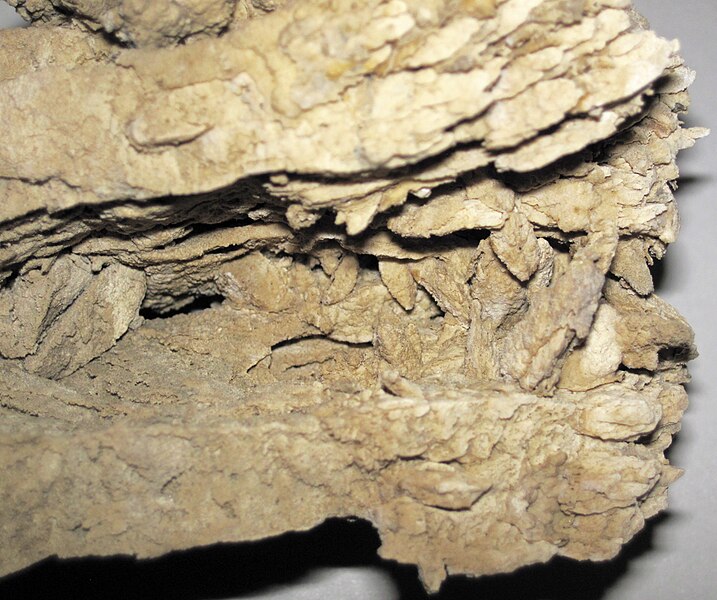File:Thinolite tufa (Quaternary; Pyramid Lake or Winnemucca Lake, north of Nixon, Nevada, USA) 4.jpg

Original file (3,525 × 2,948 pixels, file size: 5.21 MB, MIME type: image/jpeg)
Captions
Captions
Summary[edit]
| DescriptionThinolite tufa (Quaternary; Pyramid Lake or Winnemucca Lake, north of Nixon, Nevada, USA) 4.jpg |
English: Lacustrine thinolite tufa from the Quaternary of Nevada, USA.
Calcareous tufa is a scarce, calcitic, finely- to coarsely-crystalline textured, chemical sedimentary rock. It principally forms around cold springs having water relatively rich in dissolved calcium carbonate. Calcareous tufa is often characterized as a lightweight, porous, friable precursor to travertine (another calcitic, chemical sedimentary rock). The tufa specimen seen here is from the shoreline area of a western Nevada lake. It precipitated chemically and/or microbially from lacustrine water during the Pleistocene Ice Age. It is coarsely crystalline - such specimens have been referred to as thinolite, or thinolitic tufa. Thinolite is considered a synonym of glendonite, a "variety" of calcite (CaCO3). This material started out as a crystalline mass of ikaite, a hydrous calcium carbonate mineral (CaCO3·6H2O). Ikaite only forms in near-freezing water (~0º to 7º C) of high alkalinity, in organic-rich sediments at the sediment-water interface. At warmer temperatures, ikaite is not stable, and the mineral loses its water content and converts to calcite (anhydrous calcium carbonate). During the ikaite-calcite conversion, the original crystal structure of the ikaite may be retained. Calcite masses that retain ikaite crystal shapes are called glendonite (or, in this case, thinolite). The terms "glendonite" and "thinolite" do not refer to minerals; rather, they refers to the pseudomorph of calcite-after-ikaite. Pseudomorphs ("false-forms") are minerals that have replaced a previous mineral, but have retained the original crystal form. The presence of glendonite in a succession of rocks is diagnostic evidence for the presence of cold water temperatures and proximity to glaciers. Many ancient successions known to be deposited in glacial settings have glendonite. Locality: undisclosed locality about 25 miles ~north of the town of Nixon (this probably refers to the shoreline area of Pyramid Lake or possibly Winnemucca Lake), southern Washoe County, western Nevada, USA Info. at: pubs.usgs.gov/circ/2004/1267/pdf/Tufas%20of%20Pyramid%20L... |
| Date | |
| Source | https://www.flickr.com/photos/47445767@N05/51460227216/ |
| Author | James St. John |
Licensing[edit]
- You are free:
- to share – to copy, distribute and transmit the work
- to remix – to adapt the work
- Under the following conditions:
- attribution – You must give appropriate credit, provide a link to the license, and indicate if changes were made. You may do so in any reasonable manner, but not in any way that suggests the licensor endorses you or your use.
| This image was originally posted to Flickr by James St. John at https://flickr.com/photos/47445767@N05/51460227216. It was reviewed on 13 September 2021 by FlickreviewR 2 and was confirmed to be licensed under the terms of the cc-by-2.0. |
13 September 2021
File history
Click on a date/time to view the file as it appeared at that time.
| Date/Time | Thumbnail | Dimensions | User | Comment | |
|---|---|---|---|---|---|
| current | 17:55, 13 September 2021 |  | 3,525 × 2,948 (5.21 MB) | Ser Amantio di Nicolao (talk | contribs) | Uploaded a work by James St. John from https://www.flickr.com/photos/47445767@N05/51460227216/ with UploadWizard |
You cannot overwrite this file.
File usage on Commons
There are no pages that use this file.
Metadata
This file contains additional information such as Exif metadata which may have been added by the digital camera, scanner, or software program used to create or digitize it. If the file has been modified from its original state, some details such as the timestamp may not fully reflect those of the original file. The timestamp is only as accurate as the clock in the camera, and it may be completely wrong.
| Camera manufacturer | Canon |
|---|---|
| Camera model | Canon PowerShot D10 |
| Exposure time | 1/60 sec (0.016666666666667) |
| F-number | f/11 |
| ISO speed rating | 80 |
| Date and time of data generation | 13:01, 8 September 2021 |
| Lens focal length | 11.614 mm |
| Width | 4,000 px |
| Height | 3,000 px |
| Bits per component |
|
| Pixel composition | RGB |
| Orientation | Normal |
| Number of components | 3 |
| Horizontal resolution | 180 dpi |
| Vertical resolution | 180 dpi |
| Software used | Adobe Photoshop Elements 18.0 (Macintosh) |
| File change date and time | 20:52, 12 September 2021 |
| Y and C positioning | Co-sited |
| Exif version | 2.21 |
| Date and time of digitizing | 13:01, 8 September 2021 |
| Meaning of each component |
|
| Image compression mode | 3 |
| APEX shutter speed | 5.90625 |
| APEX aperture | 6.90625 |
| APEX exposure bias | −0.66666666666667 |
| Maximum land aperture | 4 APEX (f/4) |
| Metering mode | Pattern |
| Flash | Flash fired, compulsory flash firing, red-eye reduction mode |
| Supported Flashpix version | 1 |
| Color space | sRGB |
| Focal plane X resolution | 16,460.905349794 |
| Focal plane Y resolution | 16,483.516483516 |
| Focal plane resolution unit | inches |
| Sensing method | One-chip color area sensor |
| File source | Digital still camera |
| Custom image processing | Normal process |
| Exposure mode | Manual exposure |
| White balance | Auto white balance |
| Digital zoom ratio | 1 |
| Scene capture type | Portrait |
| Lens used | 6.2-18.6 mm |
| Date metadata was last modified | 16:52, 12 September 2021 |
| Unique ID of original document | A67D39C4313E31F7CA2EF7B59FC4CB88 |